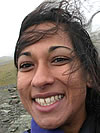
Aradhna Tripati
University of California at Los Angeles
2017 Bromery Award for Minorities
Presented to Aradhna Tripati
Citation by Raymond V. Ingersoll
Aradhna Tripati is a worthy recipient for the Bromery Award based on her research accomplishments and outreach efforts. The daughter of immigrants from Fiji, Aradhna was born in Texas and grew up in Los Angeles. She received her B.S. from California State University–Los Angeles and her Ph.D. from the University of California at Santa Cruz, and is now an associate professor at the University of California at Los Angeles. Aradhna is a paleoclimatologist who uses the geologic record to understand physical, chemical and biological processes. Her primary tools are geochemical, including the clumped-isotope paleothermometer. She has mentored more than 120 high school, undergraduate, and graduate students, and postdoctoral scientists, many of whom are minorities. Other outreach activities include talks to the Association of Black Women in Higher Education, the Society for the Advancement of Chicanos and Native Americans in Science and STEM undergraduates. She gives interviews about research, providing a powerful role model of a woman of color in leadership.
2017 Bromery Award for Minorities — Response by Aradhna Tripati
It is an honor to be receiving GSA’s Bromery Award established by Bill and Cecile Bromery.
Although it is now over half a century after the Civil Rights Act of 1964, our collective actions and inactions have not yet achieved equity or equality in education or employment in the geosciences or environmental science. In fact, the geosciences currently have one of the lowest rates of diversity of any STEM field. One student who was thinking of becoming a major recently told me: it feels like an act of resistance just to graduate with a degree. We now know with confidence this is not simply a pipeline issue, but is also due to problems with retention arising from climate.
Right now, there are high attrition rates for underserved groups at every educational and career stage—sometimes as high as 50%. This means we lose many more than half of the students who are interested in the field before they enter the workforce, an example of how we are doing worse than many fields.
Perhaps we need to consider what we are all doing is not enough. That diversity is not just something to include in our grant proposals and reports, but is something larger that is in fact integral to science and innovation, and to the fabric of a civil society. The presence of diversity signals the health and well-being of a field both internally and externally. A lack of diversity speaks to wasted talent, a stifling of creativity, and intellectual bias and narrowness. Our field is weaker because we have not effectively addressed diversity.
So we can and must do better, starting with transformation in our higher education institutions. Together we can work to dismantle the cultural disadvantages and biases that people face, because if we are not part of the solution, then regardless of our intent, we are part of the problem. We all need to do this work now, or else find that a decade from now, we have not moved the needle, and our fields are the dinosaurs compared to other fields.
At the University of California at Los Angeles, we have recently founded the first university center specifically focused on diversity in geoscience and environmental science. We provide multi-tier fellowships in concert with mentoring and leadership skills trainings. To broaden participation, we emphasize diversity, equity, inclusion, belonging, and community-mindedness.
With that, in my own personal story, I’ve had many ups and downs, and certainly wouldn’t be here without the support of many people. It would be impossible to name everyone who has helped me over the years but I want to just mention a few.
It started with my mom and sister, but after that, with Pedro Ramirez, Bob Stull, and Gary Novak at Cal State Los Angeles. They were outstanding mentors serving diverse students, including many from low-income backgrounds. They inspired a girl with a challenging family situation and who had not spent much time outdoors to go into the field and start breaking rocks and studying the environment. In graduate school, Christina Ravelo, Peggy Delaney, and Angela Davis were incredible role models. Harry Elderfield, John Eiler, Kristina Larsen, Tracy Johnson, Paul Barber, Kim Cobb, Jen Glass, Thure Cerling, Isabel Montañez, and Ray Ingersoll are amongst the people who have supported my career. The forward-looking leadership of the late Rich Lane, Sonia Esperança, Lina Patiño, Dena Smith, and Peter Kareiva in the programs they run inspire me. Thanks to my nominators, friends, and family. But most of all, thanks to the students and researchers I have the privilege of working with each day—these people and their stories and futures are my inspiration.
